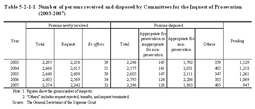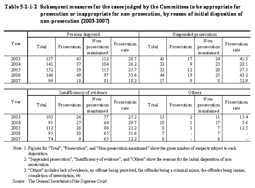| Previous Next Index Image Index Year Selection | |
|
|
1 Grievance system against non-prosecution (1) Request for reviews by Committee for the Inquest of Prosecution Committees for the Inquest of Prosecution are established with 11 members chosen by lot from the electoral roll for a term of six months. By request or ex officio, a Committee reviews the disposition of non-prosecution made by a public prosecutor and make a judgment of the case being “appropriate for prosecution”, “inappropriate for non-prosecution” or “appropriate for non-prosecution.” Conventionally the decision of the Committees for the Inquest of Prosecution had no legal binding force and public prosecutors themselves made the final judgment on prosecution taking into account the decision of the Committees. The Act for Partial Amendment to the Code of Criminal Procedure etc. (Act No. 62 of 2004) partially amended the Act for the Inquest of Prosecution (Act No. 147 of 1948) and introduced a system where public prosecution can be instituted based on a decision of the Committees for the Inquest of Prosecution under certain circumstances. The part of this Act pertaining to this system is scheduled to be enforced on May 21, 2009. Under the new system, when public prosecutors once decided not to prosecute a case and the Committees for the Inquest of Prosecution decided the case as suitable for prosecution, if public prosecutors decided not to prosecute the case again or did not institute public prosecution within a certain period of time, the Committees for the Inquest of Prosecution must carry out examination for the case again. If the Committees for the Inquest of Prosecution make a “decision that the case shall be prosecuted” (hereinafter referred to as “prosecution decision”) as a result of re-examination, the court shall designate lawyers who conduct duties of public prosecutors for the case (hereinafter referred to as “designated lawyers”) and the designated lawyers shall institute public prosecution for the case pertaining to the prosecution decision and maintain it. In addition, the amendment of the said Act will abolish the lower limit (200) for number of Committees for the Inquest of Prosecution from April 1 the same year. As a result, the 201 Committees for the Inquest of Prosecution established nationwide are scheduled to be integrated into 165 Committees. Table 5-2-1-1 shows the number of persons received and disposed by the Committees over the last five years. Table 5-2-1-1 Number of persons received and disposed by Committees for the Inquest of Prosecution (2003–2007) In 2007, the Committees newly received 2,096 persons for penal code offenses. By type of offense, the greatest number of them (478 persons) were received for negligence in the pursuit of social activities (including negligence in the pursuit of social activities related to traffic accidents on the roads but not including negligence in vehicle driving), followed by 343 persons for abuse of authority, 222 for counterfeiting of documents, 214 for injury, and 145 for fraud. Meanwhile, 178 persons were newly received for special act offenses. The greatest number of them (41 persons) was received for violations of the Labor Standards Act (Source: The General Secretariat, Supreme Court).Table 5-2-1-2 shows subsequent measures taken by public prosecutors for the cases judged by the Committee to be appropriate for prosecution or inappropriate for non-prosecution, by reason of initial disposition of non-prosecution, over the last five years. Table 5-2-1-2 Subsequent measures for the cases judged by the Committees to be appropriate for prosecution or inappropriate for non-prosecution, by reason of initial disposition of non-prosecution (2003–2007) In total, 150,770 persons were disposed by the Committees between 1949 (when the Act for the Inquest of Prosecution took effect) and 2007, including 17,190 persons judged to be appropriate for prosecution or inappropriate for non-prosecution. Among them, prosecution was instituted for 1,373 persons, and 1,227 were convicted (429 sentenced to imprisonment and 798 to fine) and 78 were found not guilty (including dismissal for judicial bar and dismissal of prosecution) (Source: The General Secretariat, Supreme Court).(2) Request to commit a case to a court for trial Request to commit a case to a court for trial is the system which allows complainants or accusers, who have an objection to a public prosecutor's disposition of non-prosecution for various types of abuse of authority, to request the competent district court to commit a case for trial. The district court shall render a ruling on whether or not to commit a case to trial depending on whether such request is well-grounded. Due to such ruling, prosecution regarding the case shall be deemed to have been instituted, and the court shall designate a person who maintains the public prosecution among the attorneys and have him/her perform the duties of a prosecutor. In 2007, the number of persons received was 202 and the number of persons disposed was 206. Commitment of the case to a court for trial was not decided for any of these cases (Source: Annual Report of Judicial Statistics and The General Secretariat, Supreme Court). |

